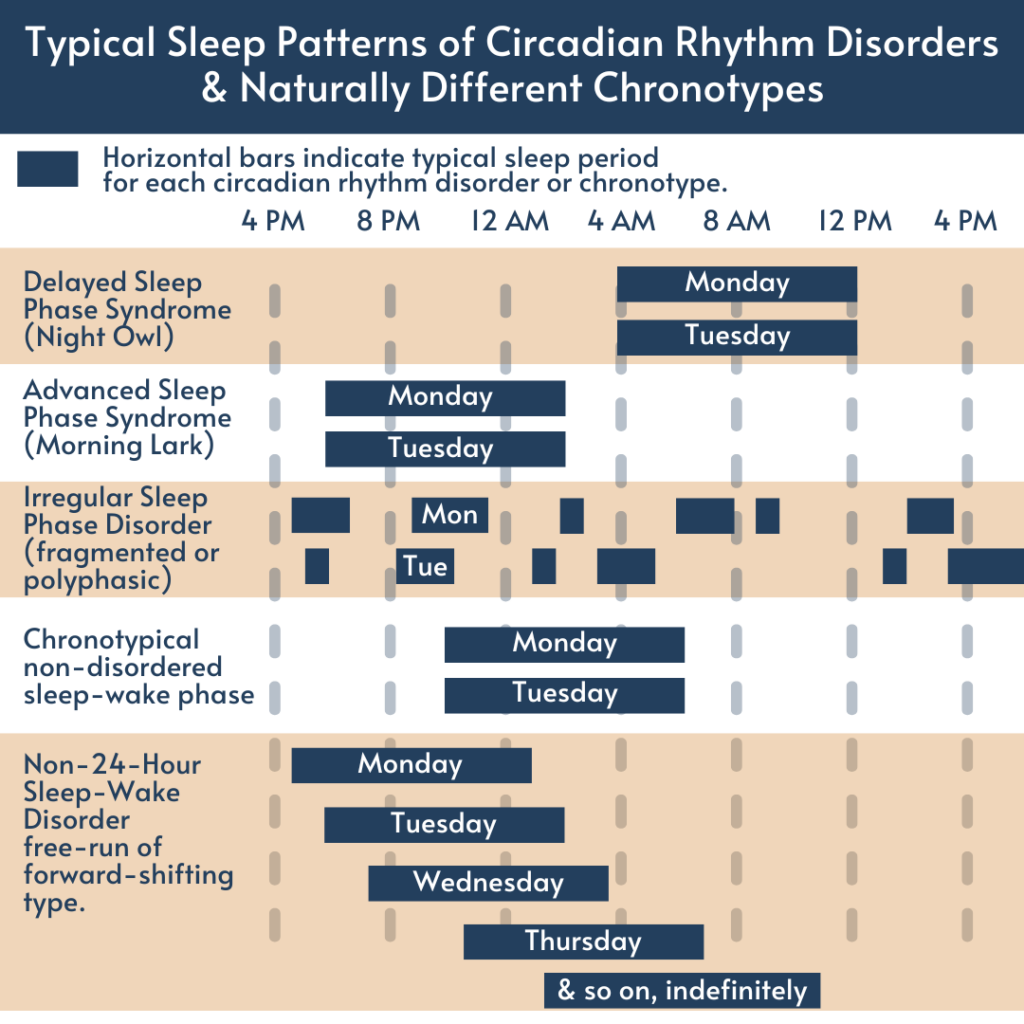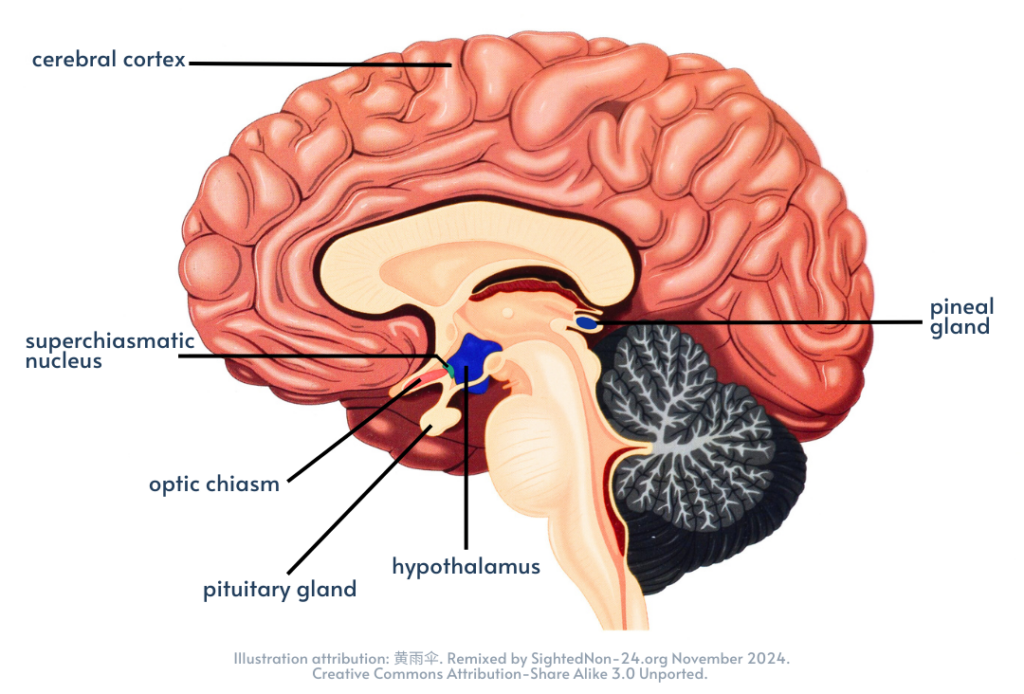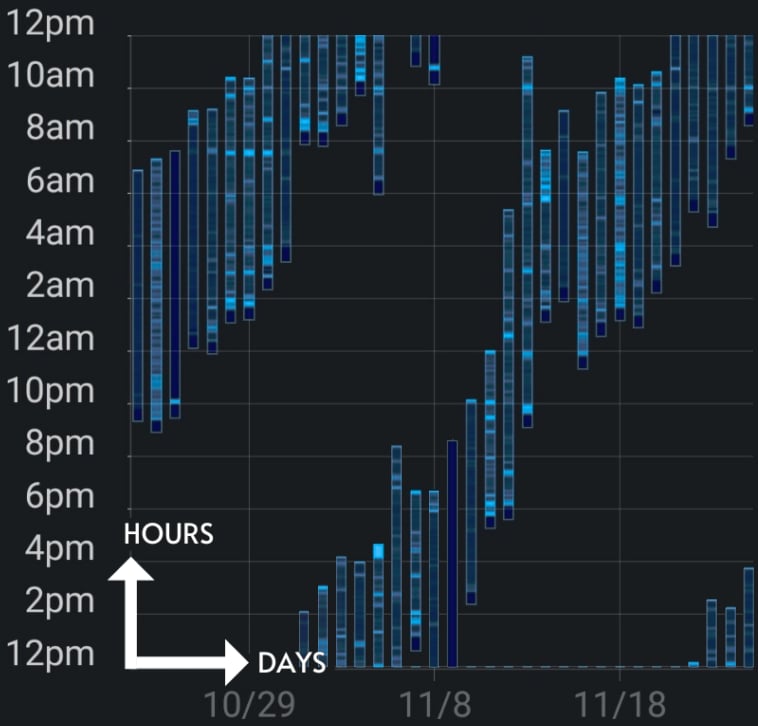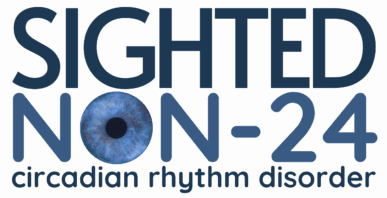Some of the terms we use as patients may not be commonly known.
Others might be unique to our community and to Non-24.
Some of these definitions may also help demonstrate the complexity of Non-24 and its complications, both in health and lifestyle.
Remember, the information provided on this website is not a substitute for professional medical advice and the website’s content should not be considered medical advice. This is a patient-led advocacy site and we are not medical professionals.
Adenoma
An adenoma is a benign (noncancerous) tumor. Sometimes, these rare growths can cause Sighted Non-24 by disrupting the normal balance of natural hormones, steroids, and chemicals made by the body. Melatonin, for example.
Adrenal Glands
The adrenal glands sit above the kidneys. They produce cortisol, aldosterone, and adrenaline. Cortisol, for example, peaks just after waking and falls throughout the day on a diurnal/daily cycle. The adrenals are critical to the body’s response to stress. Sleep deprivation, for example, is a stressor.
Chronotype
A chronotype describes a person’s circadian rhythm cycle / body clock.
E.G., “He has a night owl chronotype” … “My daughter has a Non-24 chronotype” … “Cats have a crepuscular chronotype, meaning they are most active at dawn and dusk.”
Chronodiverse
Chronodiversity or chronotype diversity is a term used to be more inclusive of different chronotypes. It is a way of accepting that some people are night owls, some are morning larks, some are chronotypical, and some have an atypical chronotype, like Non-24. SightedNon-24.org does not support sleep shaming, such as making someone feel bad for sleeping late into the day. We support a society that is more inclusive of different chronotypes.
Chronotypical
A chronotype (body clock) that aligns with society. I.E., someone who wakes up at 7 AM and falls asleep at 10 or 11 PM naturally.
Circadian Rhythm
A complex biological mechanism that controls far more than when someone wakes and sleeps; it also affects the release of hormones, the appetite, digestion, body temperature, and more. The circadian rhythm involves neurology, endocrinology, genetics, the environment, and more. Almost every cell in the human body contains a “clock,” so to speak. Therefore, when the body clock is not 24 hours long, far more than our sleep falls out of sync with the rest of the world.
Circadian Rhythm Disorders
There are four main types of circadian rhythm disorders. They include Non-24-Hour Sleep-Wake Disorder (Non-24), Advanced Sleep Phase Syndrome (ASPS/ASPD/Morning Lark), Delayed Sleep Phase Syndrome (DSPS/DSPS/Night Owl), and Irregular Sleep Wake Disorder (ISWD/polyphasic/fragmented). Primarily down to preference, some say either “disorder” or “syndrome” for ASPS/ASPD and DSPS/DSPD. This is largely down to semantics as both variations are commonly written. However, Non-24 is most always referred to as a disorder.

© 2024 Hurrier Publishing LLC for SightedNon-24.org
Cortisol
A steroid hormone made by the adrenal glands that peaks about 30 minutes after waking and continues to fall throughout the wake period. The body uses cortisol to help manage stress, inflammation, metabolism, blood pressure, and the sleep-wake cycle.
Dark Therapy
Dark Therapy restricts evening light to help the circadian rhythm know it is night and nearing sleep time. If dark therapy speeds up the Non-24 rhythm, the patient may be insensitive to light. If dark therapy slows it down, they may be sensitive to light. (Also see Light Therapy).
Diurnal
Relating or pertaining to a day; something that happens daily. May refer to a 24-hour day or daytime.
DSM-5
Also written as DSM-V, this is an abbreviation for the Diagnostic and Statistical Manual of Mental Disorders, Fifth Edition published by the American Psychiatric Association. While Non-24 is not a mental disorder, some psychiatrists may make the diagnosis. Sleep deprivation and/or how Non-24 impacts life can contribute to mental health complications. The circadian rhythm also has neurological components.
The DSM-5 diagnostic criteria for Non-24:
-
- A). A persistent or recurrent pattern of sleep disruption that is primarily due to an alteration of the circadian system or to a misalignment between the endogenous circadian rhythm and the sleep-wake schedule required by an individual’s physical environment or social or professional schedule.
-
- B). The sleep disruption leads to excessive sleepiness or insomnia, or both.
-
- C). The sleep disturbance causes clinically significant distress or impairment in social, occupational, and other important areas of functioning.
-
- D). Non-24 sleep-wake type has been associated with traumatic brain injury (TBI).
Citation: American Psychiatric Association. Diagnostic and Statistical Manual of Mental Disorders. 5th ed. Arlington, VA: American Psychiatric Association; 2013.
Entrainment
A person with Non-24 who has found an effective treatment is considered “entrained” to a 24-hour day. A Non-24 patient who follows a 24-hour schedule but is not entrained will likely have cyclical sleep deprivation or insomnia when their circadian rhythm falls out of alignment with their time-zone. To say, “I wish I could entrain to a 24-hour day” means the patient wishes they had an effective treatment or cure that allowed their body to thrive on a normal 24-hour day.
Free-Running
Refers to someone following their circadian rhythm despite its length. A free-running person wakes when refreshed and goes to sleep when they feel sleepy.
A free-running Non-24 patient will have wake-sleep times that rotate around the clock. Sometimes, patients have no choice but to free-run by following the free-running schedule of their circadian rhythm.
Someone with Non-24 either free-runs or they follow society’s schedule. An appointment that takes place when the patient will be asleep may require the patient to disrupt their free-running and become sleep deprived for a short time.
A Non-24 patient who does not free-run will likely have cyclical sleep deprivation and/or insomnia. Even if they get some sleep, that sleep may not be restful if it takes place outside of their circadian rhythm’s sleep period.
Genetics & Gene Mutations
The circadian rhythm is also largely controlled by genes in our DNA. Some cases of Sighted Non-24 may be familial, but these specific mutations have not been identified yet, although researchers are working to uncover more genes that may play a role in Non-24 and other circadian rhythm disorders. A few of the genes involved in circadian processes are: CLOCK, BMAL1 (ARNTL), PER1, PER2, PER3, CRY1, and CRY2.
The 2017 Nobel Prize in Physiology or Medicine was won by Jeffrey C. Hall, Michael Rosbash, and Michael W. Young for discovering the “period” (PER) and “timeless” (TIM) genes in fruit flies. These genes control the production of proteins that oscillate over a 24-hour cycle which act as a molecular clock within the cell.
Hetlioz (tasimelteon)
The only FDA-approved drug to treat Non-24, whether sighted or blind. It was developed by Vanda Pharmaceuticals and approved by the FDA in 2014. Their advertising and branding for Hetlioz primarily focuses on blind Non-24. Additionally, “20% of patients who received Hetlioz (8 out of 40) were able to adjust to the 24-hour clock after 1 months of treatment, compared with around 3% of patients on placebo (1 out of 38)” [EPAR summary]. In the US, Hetlioz is only distributed by two specialist pharmacies that we’re currently aware of; as of November 2024, GoodRx lists the drug price as anywhere from $38,400 – $348,300 USD per year. Therefore, many patients must have their doctor send an appeal to insurance after writing the prescription. Vanda Pharmaceuticals has some resources to help patients and doctors get access to the medication HERE.
HPA Axis
(hypothalamic-pituitary-adrenal axis) is a central stress-response system that regulates the release of cortisol. It involves communication between the hypothalamus, pituitary gland, and adrenal glands. The HPA axis influences the circadian rhythm by driving the daily fluctuations of cortisol. The cortisol rhythm also helps regulate sleep-wake cycles, energy levels, and other circadian-regulated processes. Dysregulation of the HPA axis can disrupt the circadian rhythm. Mycotoxins from certain toxic molds, for example, are known HPA axis disruptors. There is also some hypotheses to suggest the HPA axis may also play a role in mental illnesses; in cases where Non-24 is a comorbidity of mental illnesses like bipolar disorder, the HPA axis may play a role.
Hypothalamus
The area of the brain that controls sleep is located in the hypothalamus. Specifically, the superchiasmatic nucleus (SCN) located in a small region of the hypothalamus is responsible for regulating sleep cycles. Traumatic Brain Injury (see below) is a known cause of Sighted Non-24.

Jet Lag
Jet lag, medically known as desynchronosis, is a temporary sleep disorder resulting from the disruption of the body’s internal circadian rhythm due to rapid travel across multiple time zones. Symptoms include fatigue, insomnia, irritability, digestive issues, and difficulty concentrating. It occurs because the body’s natural clock struggles to adjust quickly to the environmental cues of the new time zone. This definition is primarily for chronotypical people without Non-24.
When Non-24 patients are unable to free-run, they may experience symptoms similar to jet lag. Refraining from free-running for some Non-24 patients can produce symptoms worse than typical jet lag.
Light Therapy
Commonly prescribed as a first-option treatment for Non-24, light therapy usually requires the patient get light exposure within 30 minutes of waking, ideally right away. The light source is usually a 10,000 lumen/lux bright-light therapy lamp such as what is commonly used by Seasonal Affective Disorder (SAD) patients. An example of these lamps is available here [New York Times].
There are also wearables such as the Luminette®. Some patients may respond differently to different light therapy lamps, such as wearable vs stationary.
One Reddit user compared over 35 light therapy lamps here.
Melatonin
A hormone produced by the pineal gland in the brain, primarily in response to darkness. Melatonin helps regulate sleep-wake cycles. It is synthesized from serotonin, derived from the amino acid tryptophan. Melatonin levels naturally rise at night and decrease during the day. In cases of Blind Non-24 (without light perception), patients may not get the light cues needed to make melatonin correctly. This is the primary reason melatonin as a chronobiotic and/or melatonin agonists like Hetlioz are prescribed by doctors to treat Non-24. This is also why they may not be effective treatments for Sighted Non-24 patients who may still have normal light cues.
-
- Melatonin as a Hypnotic
-
- A hypnotic is a substance that induces and sustains sleep.
-
- When used as a hypnotic, melatonin is prescribed in higher doses (e.g., 2–5 mg) to induce sleep by promoting drowsiness, often for short-term relief of insomnia. The amount of a hypnotic dose may differ from patient to patient. Melatonin as a hypnotic is not a typical treatment for Non-24 since it is used more often in the short-term.
-
- Melatonin as a Hypnotic
-
- Melatonin as a Chronobiotic
-
- A chronobiotic is a substance that adjusts or stabilizes the timing of the body’s internal circadian rhythms to align with environmental cues.
-
- When used as a chronobiotic, melatonin is prescribed in much lower doses (e.g., 0.1–0.5 mg) to help reset or stabilize the circadian rhythm. A chronobiotic dose is more commonly used in treating Sighted Non-24 and other circadian rhythm disorders. To achieve this low dose, a tincture of melatonin is usually required so the patient can start with one drop and increase until the correct dose is found. This process can take months. Even still, melatonin is not always an effective treatment for Non-24.
-
- Melatonin as a Chronobiotic
-
- Melatonin Testing (DLMO)
-
- The most common method is salivary melatonin testing which tracks the dim light melatonin onset (DLMO), a key marker of circadian phase. This testing can help diagnose circadian rhythm disorders, evaluate the impact of light exposure or medications, and guide the timing of interventions like melatonin supplementation.
-
- Melatonin Testing (DLMO)
Mycotoxins
Chemicals produced by various molds that may disrupt the HPA axis. Complications of mycotoxin exposure may include chronic fatigue, dysautonomia and neurological complications (both CNS and ANS), headaches/migraine, brain fog, flu-like pains, muscle and joint pain, neuropathy, hormone disruption, immunosuppression, and more. While it has never been studied in humans, mycotoxins are a promising field for researchers to better understand the possible role of these toxins in circadian rhythm disorders.
Neurodivergence & Autism Spectrum
Autism and neurodivergence can contribute to circadian rhythm disorders due to differences in the regulation of melatonin production, sensory processing, and environmental adaptability. People on the autism spectrum often exhibit irregular melatonin secretion patterns, leading to delayed sleep onset or fragmented sleep.
Heightened sensory sensitivities and difficulty adjusting to environmental cues, such as light and social routines, may disrupt the alignment of their internal circadian clock with the external environment.
In short, autism spectrum is likely to be another possible underlying cause of Sighted Non-24. Although, this has not yet been defined as an underlying cause of Non-24 in formal medical definitions. Unfortunately, Sighted Non-24 is not often studied due to how rare it is.
Non-24 / N24
With Non-24, the body’s internal clock operates on a schedule that is anything other than 24 hours. For someone with an internal clock that is longer than 24 hours, the times when your body expects to sleep and wake gradually shift later and later each day. Over time, this leads to a complete reversal where the body expects to sleep during the day and be awake at night. This sleep-wake cycle continues to shift forward in a repeating pattern. There will be brief periods when your internal rhythm aligns with the 24-hour day, allowing you to be awake and well-functioning during normal, social hours… but this alignment is temporary, and the cycle of misalignment begins again. Over and over.
Photophobia
Also known as light sensitivity. Photophobia is a disruptive sensitivity to light. Despite the term, it is not a fear of light. Rather, it’s a medical sensitivity to light typified by discomfort or pain in the eyes when exposed to light, especially sunlight, bright lights, or any lights that unaffected people tend to tolerate well.
If the eyes are extra sensitive to light, bright light therapy may lengthen the day-length of those with Sighted Non-24, thereby making the patient shift forward around the clock more quickly. Dark therapy may be beneficial in entraining to a 24-hour day for Sighted Non-24 cases caused by light sensitivity.
Patients with light sensitivity (and light insensitivity) may also see seasonal changes in their sleep pattern. Those who are light-sensitive may speed up in the summer and slow down in the winter. Those who are light-insensitive may speed up in the winter and slow down in the summer.
In short, the way the circadian rhythm reacts to either light therapy or dark therapy may reveal a problem with how the body processes light.
Pineal Gland
By responding to signals from the suprachiasmatic nucleus (SCN, the brain’s master clock), the pineal gland helps synchronize other biological processes tied to the sleep-wake cycle. The pineal gland is a small, pea-shaped endocrine gland in the brain that produces melatonin. It regulates melatonin in response to light and dark cues. With darkness, the pineal gland signals the body to prepare for sleep. With light exposure, it reduces melatonin production, promoting wakefulness.
Pituitary Gland
Located at the base of the brain, the pituitary plays a crucial role in regulating the circadian rhythm by releasing hormones that influence various bodily functions, including sleep and wakefulness. It works closely with the hypothalamus to maintain balance in the endocrine system, impacting hormones like cortisol, which follows a daily rhythm. Disruptions in the pituitary’s function, such as those caused by pituitary adenomas (benign tumors), can lead to hormonal imbalances that may affect sleep patterns, mood, and overall circadian rhythm regulation.
Seasonal Affective Disorder (SAD)
SAD is a type of depression that occurs at specific times of the year, most commonly during the fall and winter months when daylight hours are shorter. It is thought to be related to changes in sunlight, which can affect the production of melatonin and serotonin, disrupting the body’s circadian rhythm and mood regulation. In addition to the typical winter-onset SAD, some individuals experience “reverse SAD” or “summer SAD,” where depressive symptoms emerge in the warmer months, possibly due to factors like longer days, heat, or disrupted sleep patterns.
Sighted Non-24 patients should be aware of SAD if they free-run and are regularly awake nights. They should also consider asking their doctor about checking Vitamin D levels regularly.
The bright light therapy lamps used in the treatment of SAD are also used in light therapy prescribed to Sighted Non-24 patients. These lamps produce 10,000 lux/lumens. Example of bright light therapy lamps from the New York Times: linked here.
Sleep Hygiene
Practices to help improve the quality of sleep.
Examples of sleep hygiene include, but are not limited to:
-
- Creating a relaxing bedtime routine like reading, taking a warm bath, meditating, breathing techniques, gentle yoga, etc.
-
- Limiting screen time, such as avoiding screens that emit blue light (phones, tablets, TVs) at least 30-60 minutes before bed, as blue light can interfere with melatonin production.
-
- Optimizing your sleep environment by keeping your bedroom dark, quiet, and cool to promote restful sleep.
-
- Avoiding large meals, caffeine, and alcohol before bed.
-
- Using the bed only for sleep. Avoiding using the bed for activities like working on the computer or watching TV will help strengthen the mental association between your bed and sleep.
Please Note: Non-24 patients may find the suggestion of using sleep hygiene techniques to “fix” their sleep schedule as offensive or rude. No amount of sleep hygiene will cure Non-24. When friends, family, or acquaintances suggest sleep hygiene, it demonstrates a lack of understanding by invalidating the severity of Non-24. Non-24 cannot be cured by willpower or sleep hygiene, but sleep hygiene may help patients sleep better, just like these techniques may help chronotypical people sleep better. Often times, one of the most common sleep hygiene techniques is “keep a consistent sleep schedule.” Because that is often impossible for those with Non-24, this suggestion is often perceived as offensive.
Sleep Log
A diagnostic and/or lifestyle tool to help visualize the circadian pattern. Non-24 is typically diagnosed by creating a sleep log. This is a chart created to visualize the sleep pattern. The log should last two weeks or longer. Some Non-24 patients, especially those who free-run, find indefinite logging useful for the ability to reflect on recent sleep changes and to predict the upcoming sleep schedule.
Note from the Admin: I have kept a constant sleep log using the app Sleep As Android for seven years! I find it very useful to be able to look back at where my free-running sleep as been recently. It is also a validating and useful tool to present to practitioners, as needed. My personal sleep log is in the graphic below.

Sleep Shaming
SightedNon-24.org also advocates to end sleep shaming. Sleep shaming may include judging someone for sleeping outside of societal norms. “You’ve wasted the day away sleeping!” or “Why can’t you just set an alarm and get up earlier?” are examples of sleep shaming. Some may experience cruel judgements whether they sleep late or not. For another example, “Glad you finally got up for breakfast for once!” We do not agree with making someone feel bad for being a night owl or sleeping at different times of day. Our community is a welcoming environment for anyone who has experienced this.
Our social media pages are the home of #StopSleepShaming and we also use #EndSleepShaming.
Superchiasmatic Nucleus (SCN)
Also called the “master clock,” this small area of the brain located in the hypothalamus largely controls the circadian rhythm.
Traumatic Brain Injury (TBI)
A TBI can disrupt the brain’s ability to regulate the circadian rhythm. It can affect areas like the hypothalamus and the suprachiasmatic nucleus (SCN). This disruption can lead to circadian rhythm disorders, such as Non-24. A TBI can impair the body’s ability to properly synchronize with external cues like light and darkness. This is a medically confirmed cause of Non-24 and is mentioned in the diagnostic criteria for Non-24.
Vitamin D
Low levels of vitamin D have been associated with sleep disturbances, including insomnia and poorer sleep quality, potentially due to its effect on melatonin production and the regulation of other sleep-related mechanisms. Sighted Non-24 patients who free-run and are awake at night often may consider asking their doctor to check vitamin D levels. Even still, not all people can make vitamin D from sun exposure due to genetic mutation. For Non-24 patients, this may be a good test to run regularly. (Note from the admin: I personally feel best when my Vitamin D test result falls between 60 – 80 ng/ml, but this doesn’t seem to affect my sleep, personally. Vitamin D is usually measured on a scale of 30 – 100 ng/ml).
Wake Period & Sleep Period
Sometimes “morning” and “night” can be difficult terms to use when your sleep period and wake period are constantly shifting. Some Non-24 patients use the term, “my morning” or “my evening” instead of the typical social morning or social evening. It can be useful to say, “sleep period” or “wake period” instead of daytime or nighttime when referring to sleep-wake times because they often do not line up with actual day or night.
Please contact us if you have other definitions contribute, any corrections, or other suggestions.
